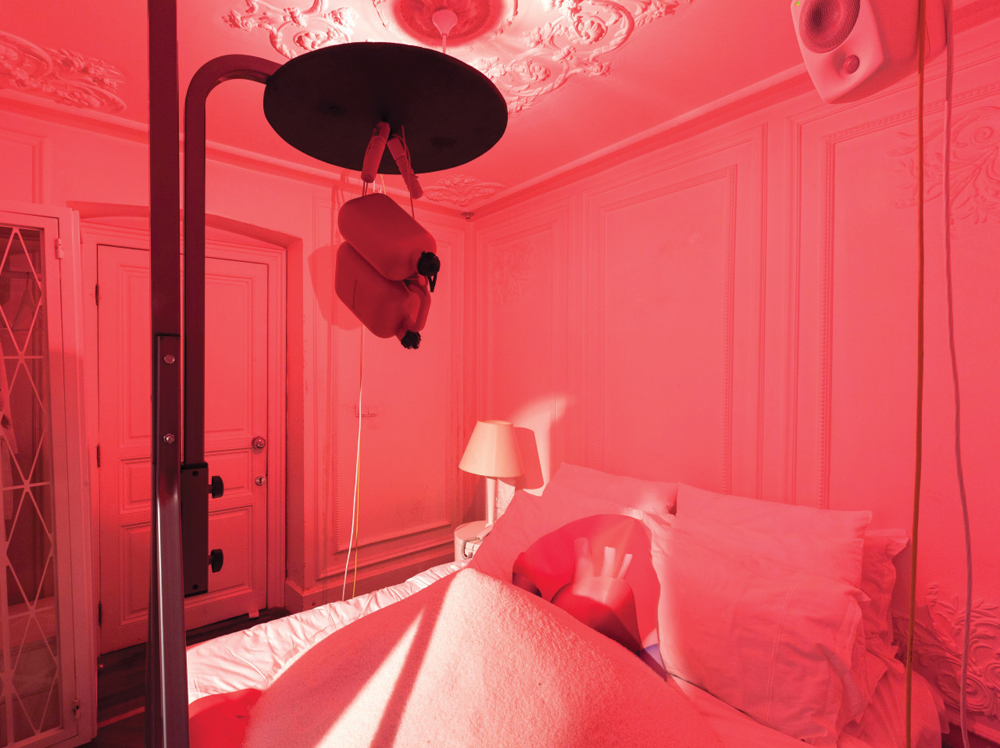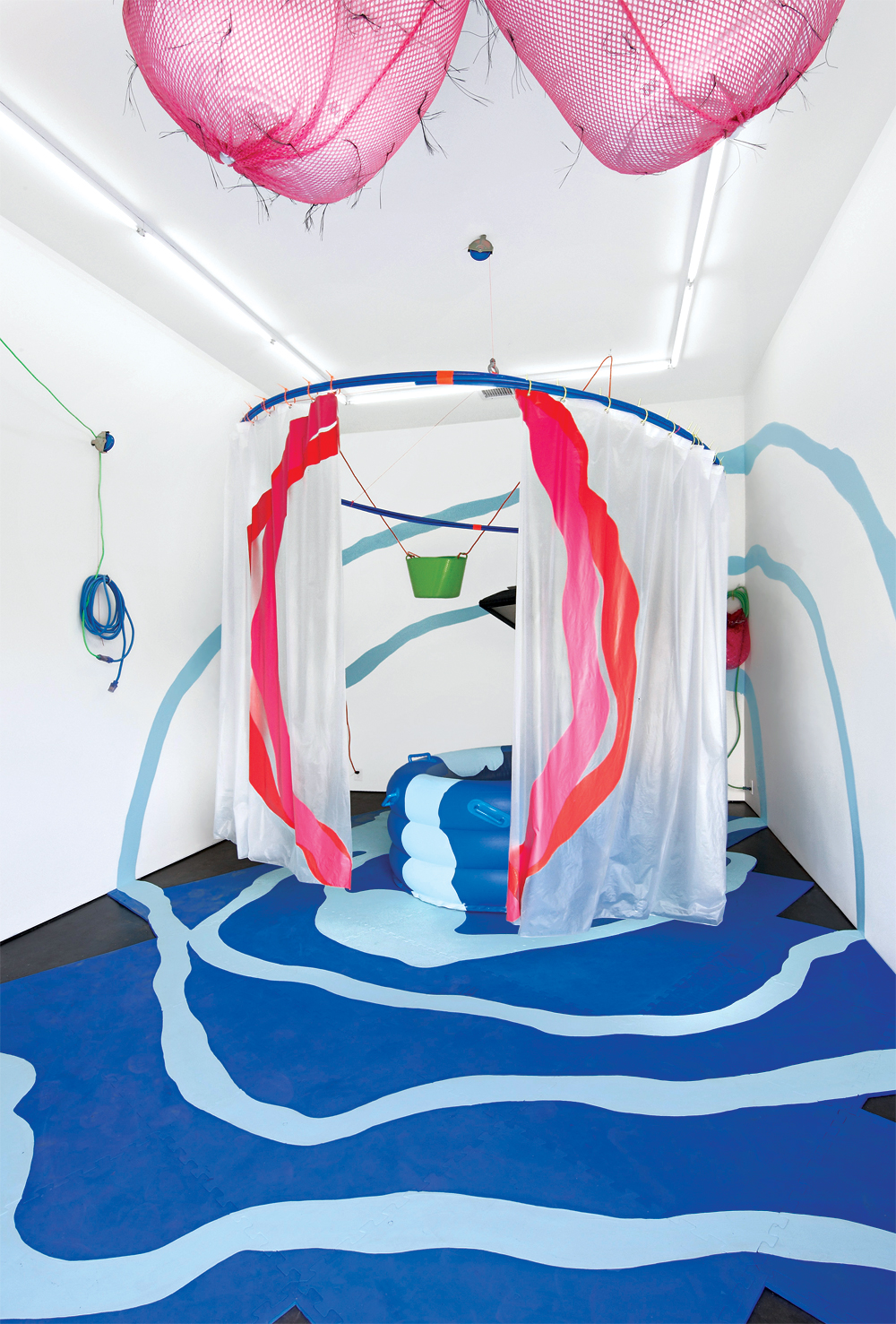Between Worlds
Labyrinthine associations and elastic meaning in the work of Heather Phillipson
Labyrinthine associations and elastic meaning in the work of Heather Phillipson

‘I’ve had enough of Being and Time / and of clothing’, writes Heather Phillipson in what is, perhaps, her best-known poem, ‘German Phenomenology Makes Me Want to Strip and Run through North London’ (2009). Phillipson likes long and often disorientating titles, such as ‘immediately and for a short time balloons weapons too-tight clothing worries of all kinds’ (2013) and ‘yes, surprising is existence in the post-vegetal cosmorama’ (2014), but the first lines of ‘German Phenomenology …’ seem to condense many of her preoccupations into a moment of atomic implosion: tired of being, tired of time, tired of thinking about Being and Time (1927), one foot lifted to bail out the door and go roaring naked through the streets. It’s the same multitude of meanings and possibilities, the same structural imbalancing act, which gives energy to her riotous, many-voiced installations, combining words, video, prints and collages; labyrinths of association that the visitor is warmly invited into and then, just as courteously, spun around in and baffled.
Phillipson’s 2013 show at BALTIC Centre for Contemporary Art required visitors to duck through a banana-framed orifice into a dark room, board a speedboat adrift on a sea of mineral-water bottles and experience a virtual-reality car ride before being cast out of the gallery space entirely for a surreal, video-led walking tour of the city. Threaded through the works was an insistence on the power of language to both describe and dissemble, to evoke passion without reducing it: ‘What happens in your mouth might not stay in your mouth. Other people’s tongues, for example’. In the installation UN/FIT FOR FEELING, at the 14th Istanbul Biennial last year, the subject was not the mouth but the heart, with all its pulsing multitude of associations. Pink-lit rooms were filled with stacks of tyres, sports equipment, tubes, beds and screens, evoking not just the heart but ‘the space of the heart’: the desire of the hotel room, the anxiety of the changing room; emotion and exertion. The one constant in Phillipson’s work is that nothing is ever allowed to settle. Her constructions slip and slide unpredictably from one toppling pile to another. They evoke a world in which the absence of easily consumed meaning has been literalized by the collapse of media. What is at stake is how to live in such a world, where only the full spectrum response of the multidisciplinary artist can begin to encompass all of its possibilities.

Phillipson’s published poetry includes collections for Bloodaxe (Instant-flex 718, 2013) and Faber & Faber (in the ‘New Poets’ series, 2009), as well as the typically fidgety NOT AN ESSAY (2012, Penned in the Margins), a book whose title hopelessly renounces its own meandering course. The poems abound with sudden stoppages and images of infinity, with questions of scale and the slippages between them. ‘Within the Cooling-off Period’, a poem from Instant-flex 718, attempts to find its ground by listing significant moments in the early 21st century: ‘SELENE spacecraft had just blazed into the atmos. / 3D goggles were en route to common usage,’ but the attempt is fruitless, no firm position can be held. ‘It was like this: from a drop of water, / a logician could infer the Atlantic Ocean.’ I know that SELENE was a Japanese spacecraft that orbited the Moon for 18 months of the last decade before burying itself in the lunar surface. It was the first probe to send back detailed images of the floor of the Shackleton crater at the Moon’s south pole, a place frozen in such perpetual darkness that it’s possible water ice might still be present there, waiting for our arrival, to become a new wellspring. But perhaps I’m making too much of the referents, becoming obsessed with the grain when I should be seeing the bigger picture – not the impact, but the blazing passage.
In FINAL DAYS, her installation for Sheffield Doc/Fest 2015 (with Serpentine Galleries), Phillipson built a series of arenas around the theme of a department store, consisting of shrines to hosiery, underwear, towels and textiles, multiple video screens and multiple video loops piled up on cardboard boxes and cut-outs of legs and torsos, towels and body parts, and scattered with deckchairs for the (dis)comfort of the viewer. The work occupied a floor of Castle House, an actual but defunct department store, and it’s easy to see in its boxing-up of sales and sensations a farewell to physical experience, as palpable wares are replaced by digital hands caressing virtual goods. Of course, this realization is immediately undone by the tactility and eroticism of the installation itself, partaking gleefully of all the colour and sheen of commercial materialism. In UNDERWEAR, one of the video components, Phillipson fixates on the disembodied crotch of a Jockey underpants model, squishing strawberry gum into its groin, grateful for its lack of a face while bemoaning its absence of breath, before cutting to ‘real’ jockeys on virtual horses who gallop across the screen in a desperate show of vitality. But, again, we shouldn’t jump to conclusions. FINAL DAYS, says Phillipson, is unusual in her work for its site-specificity and loaded context. Perhaps, as the narrator of underwear suggests, it’s possible we’ve misunderstood every word. Take nothing for granted here: just take everything.

When I speak to her, Phillipson is reworking FINAL DAYS for Performa 15 in New York, where it will take on another space, another form, another architecture and, thus, another meaning – or many of them. All of Phillipson’s works, in fact, lend themselves to these reworkings and redistributions, a built-in resistance to fixity which finds its echo in the visitor’s experience; less, again, of an impact than a trajectory. Even the online experience of versions of the works is enfolded into the artist’s practice as just another route through, another redistribution. Phillipson has the gift of making such chrome-plated encounters as confusing and disorientating as being lost in a dark room, as hearing voices – the same effects she deploys so effectively in her physical works. sub-fusc love-feast, her installation at Dundee Contemporary Arts in 2014, is documented online in video shot from a miniature drone, an infernal buzzing thing, whose incessant whirring drowns out Phillipson’s narration, but whose nauseating, inhuman passage around, over and through elements of the work – cut-out flamingos, immense fruits, more splayed legs – feels, paradoxically, like the most human experience of the work we could have.
The elements of sub-fusc love-feast, like FINAL DAYS, are video screens, stock images and cut-outs, projected, printed and collaged like three-dimensional Photoshop layers – or, rather, four dimensional, as the experience of navigating between them turns browser into editor. On Phillipson’s website, you can see the original cut-and-paste sketches they sprung from but, in the gallery space, they become vertiginous: you can tumble over and into them. Phillipson has called this process ‘sicking-up Google’ – that nausea again – a physical instantiation of a search history. Indeed, many of the objects have their associated search terms and tags scrawled on the back of them. (There’s literacy as well as literalism here – in a time of mass surveillance, what better metaphor for the subversive unconscious than the traces we leave online.) Behind each image is its language equivalent; its cause, or at least one take on it – a mediation between the poet and the machine. There is no distance between word and thing, just as there is no distance between thought and representation, between sculpture and poetry, website and white cube. This vomiting into space is also a collapse, a superdense core of imagination pulling everything towards it, literalizing the act of creation as collection, as (dis)organization.

Phillipson quotes Ezra Pound: ‘The natural image is always the adequate symbol,’ but it’s clear nothing can be adequate here – no individual word or image, just the ongoing blurring of one with the other, the virtual with the real, the body with the screen. And this is crucial: Phillipson’s work is just as confident partaking of the forms and modes of digital networks as it is in those of the physical world. She recognizes in the internet the tools that exist in poetry and sculpture, and simultaneously deploys the web’s unique metaphorical power, turning it into a model for the collapse of distance and of meaning that runs throughout her work. The internet’s pure and language-formed space, its existence as an extension of ourselves, our consciousness and cognition, becomes just another realm to be written and ridden: a context, not a medium. In ‘A Dramatic Look inside the Heart Makes for Interesting Viewing’, Phillipson claims: ‘Ease of communication / has ruined the heart’s eloquence, for the moment.’ All the more reason, then, not to fall prey to ease, to concision and conclusion, but to be contrary and confusing: to resist reduction.
Phillipson’s work constantly serves to remind us of the fact that all constructed meanings, and all perceived distances, are just failures of imagination. Things and representations, words and experiences, are adjacent and entangled: everything touches everything else. ‘A part can become a whole and a whole can become a part’, even if we can never fully name the whole, or the part. Phillipson’s skill is in expressing this entanglement with equal facility in a room or a line, in the slippage between wor(l)ds, as in ‘Devoted Hopelessly’, when ‘the only men it’s safe for me to love […] send me to my desk, / or down the road to get black grapes, fit, and ideas.’
In 2015, Heather Phillipson’s work was shown in exhibitions including the 14th Istanbul Biennial, Turkey, and Performa 15, New York, USA. Her solo show at Schirn Frankfurt, Germany, runs until 7 February. Forthcoming solo projects include Whitechapel Gallery, London, UK, Frieze Projects New York, Images Festival Toronto, Canada, and the 32nd São Paulo Biennial, Brazil. She has also published widely and was named a Next Generation Poet in 2014.
























